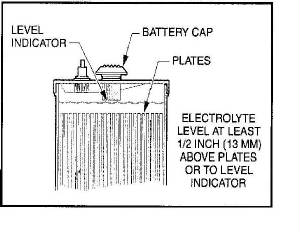GOLF CART BATTERY CARE
 To keep batteries in good working condition follow this maintenance program on a regular basis:
To keep batteries in good working condition follow this maintenance program on a regular basis:
1. The batteries should be kept clean and free of corrosion. Wash tops and terminals of batteries with a solution of baking soda and water (1 cup (237 mL) baking soda per gallon (3.8 L) of water). Rinse solution off of the batteries. Do not allow this solution to enter the battery. Be sure terminals are tight. Let the terminals dry and then coat with Battery Terminal Protector Spray (CCI P/N 1014305).
NOTE: Dispose of waste water properly.
2. The electrolyte level in the batteries should be checked weekly. Add water only after charging, unless the electrolyte level is below the top of the plates. In this case, add just enough water to cover the plates, charge and then check the level again. Never charge batteries if plates are exposed above electrolyte level. For best battery life, add only distilled water. (see diagram b
CAUTION: Do not overfill the batteries.
NOTE: A battery watering gun or bottle is available at your dealer.
3. The battery hold-downs should be tight enough so that the batteries do not move while the vehicle is in motion, but not so tight as to crack or buckle the battery case. Tighten hold-down retaining nuts to 40 in lb (4.5 N·m). The terminal connections should be clean and tight, and any worn insulation or frayed wires should be replaced. Tighten battery terminals to 110 in-lb (12.4 N·m).
WARNING:
• If the battery cable terminal ends are damaged or corroded, they should be replaced or cleaned as necessary. Failure to do so may cause them to overheat during operation and could result in fire, property damage, or personal injury.
4. After use, the batteries should be placed on charge. The batteries should never be left discharged any longer than absolutely necessary (do not leave batteries discharged overnight). This is especially important during the colder winter months, when temps drop below freezing.
Gas Vehicle Winter Storage
Preparing your vehicle for long term winter storage is a must for those who store both Electric and Gas Golf Cars. Below you’ll find tips to remember when storing your Gasoline Golf Car.
- Make sure the battery is clean- Wash the tops and terminals of the batteries w/ a baking soda and water solution (1 cup baking soda per 1 gallon of water). Then rinse solution off, dry, and coat battery terminals with Battery Terminal Protector Spray.
- Store vehicle in a cool, dry location- Batteries will “self-discharge” at a much slower rate in cooler locations and vice/versa in warmer locations.
Perform all required Preventive Maintenance procedure- Proper inflate tires and perform all semiannual periodic lubrications (See Section 10 of the M&S manuals). - Do not engage the park brake but secure the car from rolling
- Disconnect the Battery Cables- Negative cable first then positive.
- Prepare the Engine- Remove the spark plug and pour ½ an ounce of SAE 10 weight oil into the engine through the spark plug hole. Rotate the crankshaft by hand several times then install the spark plug.
- Drain the carburetor and seal the fuel tank- Place the Forward/Reverse handle in the NEUTRAL position and the neutral lockout cam in the MAINTENANCE position. Turn the fuel shut-off valve to the closed (OFF) position (Figure 3-3, Page 3-3) and run the engine until fuel remaining in the carburetor and fuel lines is depleted and the engine stalls. Return the neutral lockout cam to the OPERATE position. Loosen, but do not remove the carburetor drain screw and drain fuel remaining in bowl into a small container. Then, pour the fuel from the container into the vehicle fuel tank. Tighten the carburetor drain screw. Disconnect fuel vent line from tank vend nipple. Plug the fuel tank vent nipple so that it is air tight. We recommend using a slip-on vinyl cap. NOTE: Winter storage procedures can be found in all Maintenance and Service Manuals and Owner’s Manuals.
